-
The variety of band structures have been observed experimentally in the vicinity of
$ N \!=\! Z\! =\! 50 $ shell closures, resulted from the coupling of valence nucleons with different shape driving effects and core-excited configurations[1-2]. Also, a number of bands have been observed in$ A\!\sim\!100 $ mass region for the weakly deformed nuclei, within the framework of shears mechanism[3-5]. Other than this, new nuclear phenomena have been visualized at proton and neutron shell closures like: anti-magnetic (AMR) rotation[6-9], and band termination[5] at high spins in 98-100Ru[10], 101-102Rh[11-12], 98-100,102-103Pd[13-23], and 98,99Ag[24-25] nuclei. These different band structures with varying trends of moment of inertia and reduced transition probabilities as a function of increasing rotational spin are exhibited to have large angular momentum based on different geometrical configurations[3]. Also, the observation of slower decrease of$ B({\rm E}2) $ values in 110Cd compared to that in pure AMR bands in 106,108Cd isotopes have evidenced for the interplay between antimagnetic and core rotation[26].For the aforementioned nuclei, the antimagnetic rotation bands based on
$ g_{9/2}^{-2} $ configurations have been identified and reported in the literature on the basis of lifetime measurements performed using Doppler Shift Attenuation Method (DSAM) method[21]. And, it will be interesting to investigate the evolution of triaxiality and the effect of weakly deformed core on AMR character in Pd-isotopes. For this purpose, we have performed the theoretical investigations in the neighboring Pd-nuclei around$ N \!=\! Z\! =\! 50 $ shell closures.In the present work, a study of structural changes have been reported based on: (a) DSAM measured lifetimes present in the literature, and (b) theroretical investigations around
$ N \!=\! Z\! =\! 50 $ shell closures. This paper has been organized as follows: Firstly, the discussion about the experimental considerations reported in literature has been made based on DSAM procedure, and the related necessary key details for such a method have been made in Section 2. Also, the importance of target (with and without backing) for DSAM measurement has been discuused. Secondly, the discussion of results have been made in Section 3, based on the comparison of experimental data available in the literature with theoretical investigations performed in the present work, for nuclei with$ Z\sim46 $ . Lastly in Section 4, summary and conclusion have been given. -
The high spin states in 101Pd had been populated via different nuclear reactions presented in the Refs. [20-21]. Both of the reactions had been used to populate the excited states in 101Pd nuclei considering different experimental procedures, mainly focusing on measuring the lineshapes of the excited states based on DSAM method. The detailed consideration relevant to experimental procedures could be found in the Refs. [20-21]. The main point to discuss here is the different type of backings used in those two experiments for DSAM measurements. In one of the reference, self supporting but thick target has been used for reaction, of which some part is used as an effective target area and remaining part is used as an effective stopping area[20]. While in the Ref. [21], backed target with required thickness of backing was used to populate the states in 101Pd nuclei. So, the key importance of using the target with backing and without backing has been discussed for successfully carrying out of a DSAM measurement.
To carry out DSAM based lineshape measurement, it is required to have backing with large thickness of order
$\sim ( 8\sim10)$ mg/cm2 i.e., the backing must be thick enough to stop the residuals/recoils inside it. The stopping of the residuals produces the velocity profile in the backing assuming the negligible energy loss in target, and thus produce the lineshapes required for extracting lifetimes employing LINESHAPE program[27]. For lineshape analysis, data obtained at detectors placed at an angle were sorted and added together to obtain an angle dependent$ \gamma- $ ray spectrum. Then, the$ \gamma - \gamma $ coincidence events were sorted into three asymmetric matrices, whose$ x- $ axis was the$ \gamma- $ ray energies in the detectors placed at the same angle, while the$ y- $ axis for these matrices was the$ \gamma- $ ray energies in the detectors placed at other position. For the purpose of experimental discussion, level scheme shown in Fig. 1(a) has been taken from the Ref. [21].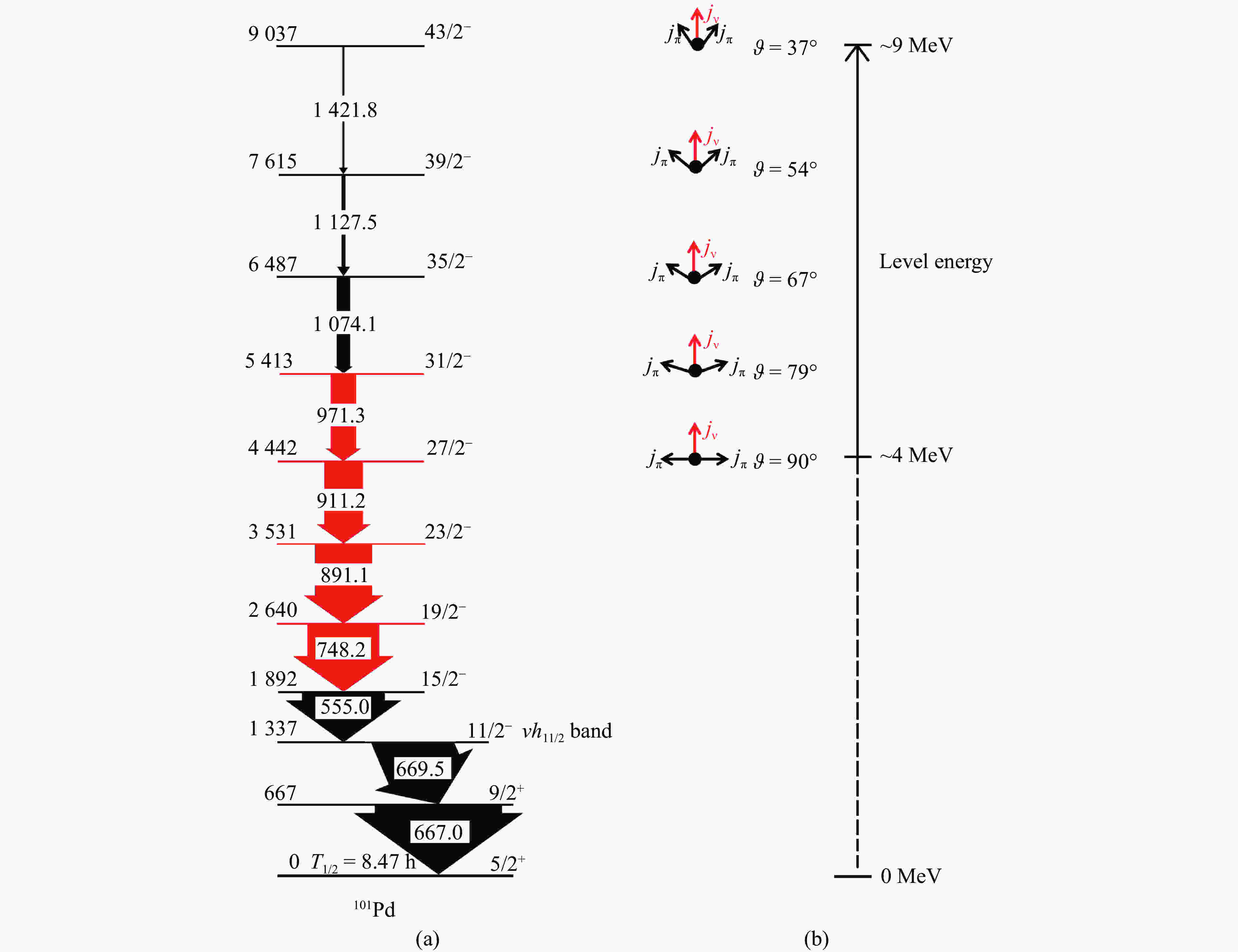
Figure 1. (color online)(a) The reproduced partial level scheme relevant for the present work has been taken from the Ref. [21]. In figure (b), the pictorial representation for the generation of angular momentum has been shown as a function of increasing level energy and spin of the level states, in
$\nu h_{11/2}$ band of 101Pd. The$\vartheta$ values in between the proton and neutron blades have been also taken from the Ref. [21]. -
The observed antimagnetic rotational bands[3, 28] in the last decades have shown a regular rotational behavior, despite of the nuclei small deformation. This has been resulted into the production of high spin excited states, with proton states more and more aligned along the neutron aligned states i.e., rotation axis. This type of alignment has resulted in an increase of angular momentum, due to the coupling of proton and neutron aligned states, known as shears mechanism, which can be seen in the pictorial representation (see Fig. 1(b)). To validate this pictorial behavior, the experimentally measured B(E2) values[29-30] are plotted and compared as a function of increasing spin. The comparison has suggested the observation of B(E2) values for 101Pd in between those observed for 100Pd and 102Pd nuclei. Other than this, the decreasing behavior of B(E2) values have been seen with increasing spin. This behavior can be characterized from the appearance of weak E2 transitions reflecting the weakly deformed core, which is one of the key factor for indication of required antimagnetic rotation character in lower part of
$ \nu h_{11/2} $ band[21]. This type of decreasing trend, suggesting the AMR behavior in$ \nu h_{11/2} $ band was also supported theoretically[20], based on semi-classical model (Refs. [17-19] of Ref. [20]). Also, the theoretical studies for AMR bands in Pd isotopes, based on particle rotor model (PRM) and tilted-axis craking (TAC) shell model[31-22] have inferred the$ \pi g_{9/2}^{-4} $ based configuration for the AMR band, within the framework of PRM. However, Refs. [18, 21, 31] have favored the$ \pi g_{9/2}^{-2} $ based configuration based on TAC and PRM calculations. The observed decreasing B(E2) values and the generated angular momentum in the neighboring nuclei, can be suggested due to the evolution of vibrational picture at lower spins, to a more rotor-like picture at higher spins[32] around$ 23/2^- $ due to the alignment of presumably$ g_{7/2} $ neutrons. This change is likely to be predicted due to configuration change of the band above$ 23/2^- $ , having an impact on the measured lifetime values and the extracted B(E2) values above this level.To check the evolution of deformation as a function of neutron number for Pd-isotopes,
$ \beta_2 $ values taken from the Ref. [33] are plotted (shown in the Fig. 2). This has been done to observe the trend of deformation in Pd-isotopes and the neighboring nuclei around$ N \!=\! Z \!=\! 50 $ shell closures. From the graph plotted for isobars ($ A\! =\! 101 $ ) and isotones ($ N \!=\! 55 $ ), in vicinity of$ Z \!=\! 46 $ , the change in shape has been observed with increasing proton number. The large prolate deformation with$ \beta_2 \sim 0.2 $ has been observed at$ Z \!=\! 44 $ with continuous decrease and reaching to small oblate deformation value at shell closures. Beyond$ Z \!=\! 50 $ , the large increase in deformation has been observed for$ N \!=\! 55 $ isotones with small increase in deformation for isobars ($ A \!=\! 101 $ ). The reason for this large increase of$ \beta_2 $ can be given due to the occupancy of more deformation driving orbital resulting in increasing prolate deformation for$ N\! =\! 55 $ isotones. For Pd- isotopes plotted with increasing neutron number (Fig. 2), nearly spherical shapes have been observed with small value of deformation for$ N \!=\! 48 $ to 52. Thereafter, a continuous rise in deformation has been observed, suggesting the inclusion of more prolate deformation driving orbital above$ N\! = \!52 $ . These two types of comparisons around$ N\! =\! Z\! =\! 50 $ have been done to check: (1) the effect of extra neutron or proton towards deformation and spherecity, and (2) at which neutron or proton number above or below Pd-nuclei, the transition of nuclear shape takes place. This check further provides the verification for one of the characteristics of nuclei lying in transitional region of$ A\!\sim\!100 $ .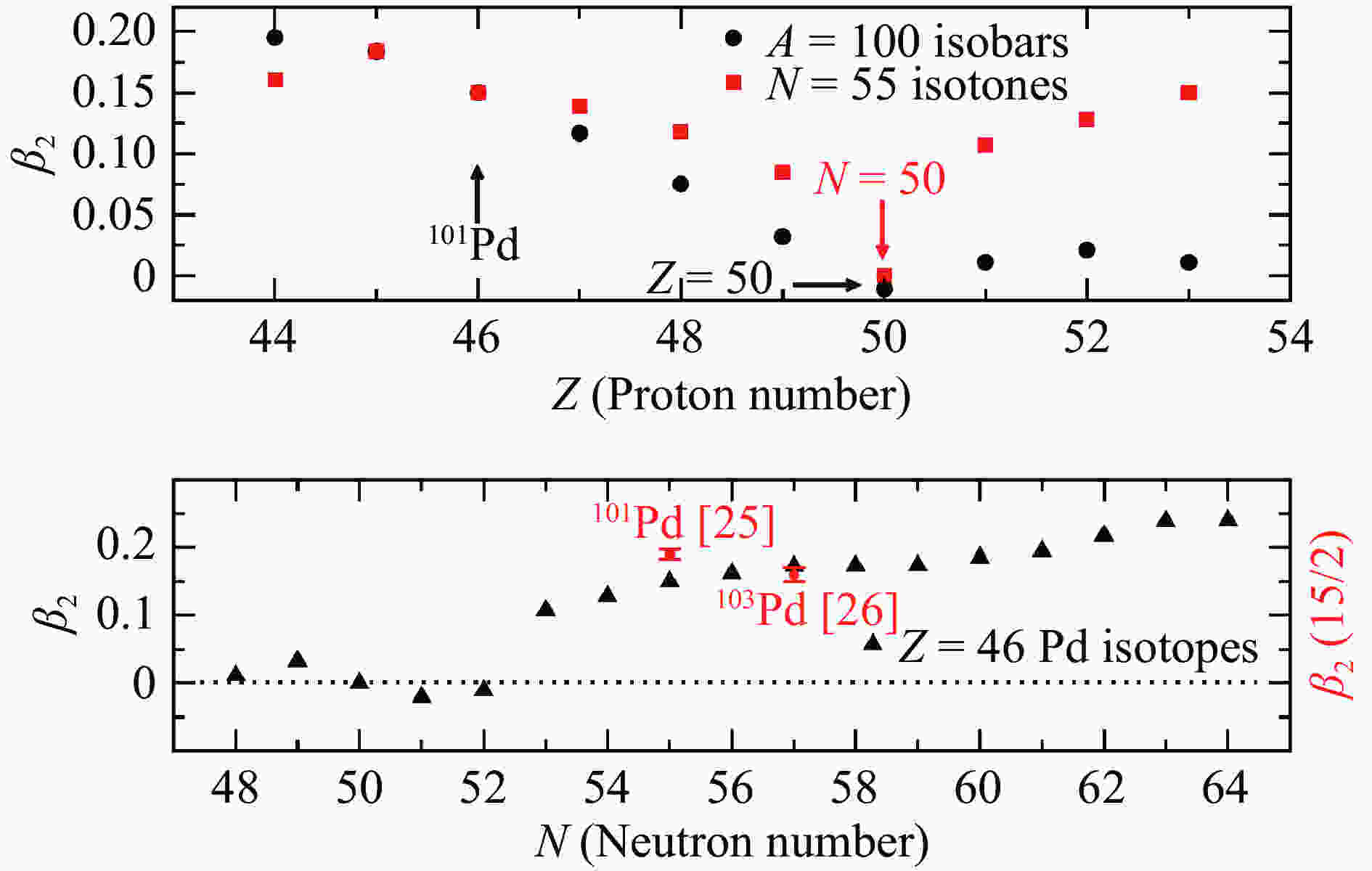
Figure 2. (color online)The deformation (same scaling has been used on left as well as right of
$y-$ axis) is plotted with increasing neutron number for Pd- isotopes (lower). In the upper figure, the deformation is plotted in the vicinity of$N \!= \!Z\! =\! 50$ shell closures. The deformation values are taken from the Atomic Data and Nuclear Tables 2016[33]. The experimentally observed$\beta_2$ values for 101Pd and 103Pd for the${15/2}^-$ state are taken from the Refs. [34-35] respectively.To visualize the nature of shape evolution around Pd-isotopes, the ratios of
$ E_{4^+}/E_{2^+} $ [36-37] have been calculated, which is one of the experimental signature of spherical and defromed shape in nuclei as suggested by casten triangle[37]. In the present case, smooth change of this ratio has been observed from 2.1 onwards, as a funciton of increasing neutron number (see Fig. 3), indicating the shape evolution from a spherical nucleus towards$ \gamma- $ soft triaxial rotor with involvement of small triaxiality ($ \gamma $ ). The deformation parameter ($ \gamma $ ) measures the degree of triaxiality. The ($ \gamma \!=\! 0^\circ $ ) limit corresponds to axial prolate shapes ($ \beta_2 > 0 $ ) while oblate axial shapes ($ \beta_2 < 0 $ ) appear at ($ \gamma \!=\! 60^\circ $ ). Intermediate values of$ \gamma- $ are associated with triaxial shapes[36-37]. This is futher supported by the performed TRS calculations presented in Ref. [34].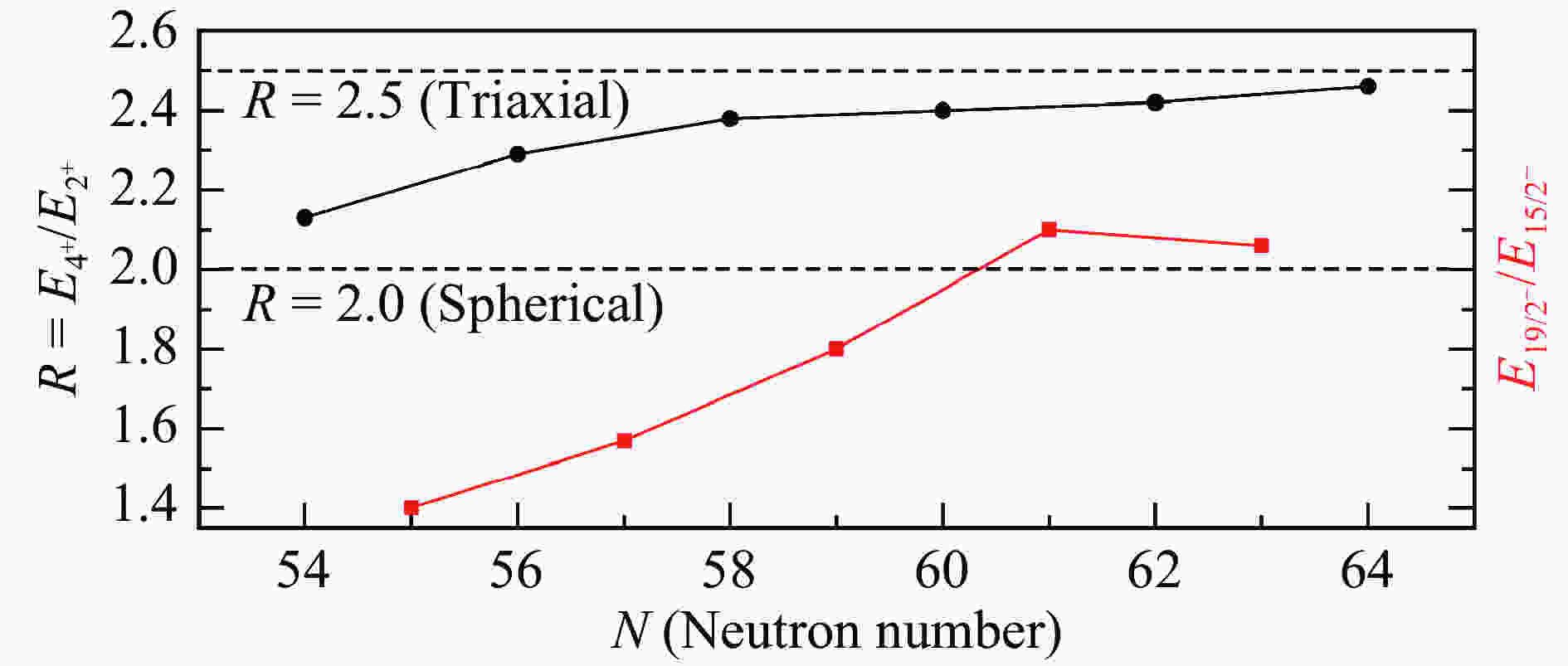
Figure 3. (color online)The ratio of
${E_4^+}/{E_2^+}$ (scaled on left of$y-$ axis) are plotted with increasing neutron number for even-A Pd-isotopes (black color) and$E_{19/2^-}/E_{15/2^-}$ (scaled on right of$y-$ axis) for odd-A Pd-isotopes (red color)[38]. On both sides of the figure, same scaling has been used as labelled on left of$y-$ axis.To get the deeper understanding about the shape of nucleus, we have performed the Total Routhian Surface (TRS) Calculations, within the Cranked Hartree-Fock-Bogoliubov (CHFB) model[39-40]. Collective rotation was investigated in the frame of the cranked shell model in three-dimensional deformation space comprising of
$ \beta_2,\; \beta_4 $ and$ \gamma $ nuclear shape parameters. The paraemeters used in TRS measurement have their usual meaning i.e.,$ \beta_2 $ is quadrupole deformation,$ \beta_4 $ is hexadecapole deformation and$ \gamma $ is the triaxiality present in the nucleus. The detailed information about the performed TRS calculations can be found in the Refs. [40-43] and the references therein. Pairing correlations are dependent on the rotational frequency and deformation. In order to study this, the TRS calculations have been carried out in deformation space for 100-102Pd, paying an attention to the evolution of$ \gamma- $ softness and triaxiality with rotation. At a given frequency, the deformation of a state was determined by minimizing the calculated TRS. The calculated equilibrium deformation indicates that our calculations are in close agreement to some extent with the results already reported in the literature. The shape evolution and nuclear softness in$ \beta_2 $ and$ \gamma $ directions are evaluated as shown in Fig. 4. The performed TRS calculations in the present work only picturizes the presence of triaxaility at higher excitations in terms of rotational frequency. On comparison of the present TRS results with the calucaltions reported in literature have predicted energy minima at ($ \beta_2, \gamma $ ) = (0.133, 1.2°)[34] for 100Pd, (0.165, 10.0°) for 101Pd (present work), and (0.160, 6.2°) for 102Pd[16] nuclei, have also confirmed the involvement of triaxiality with change in neutron number. This can be seen from the magnitude of triaxiality paramter ($ \gamma $ ) value mentioned in the parenthesis above. From the above mentioned results based on$ R_{4/2} $ and TRS measurements, shape change from vibration to rotation has been described including the small amount of triaxiality, and the effects like: rotation-vibration coupling in Pd-isotopes and in its vicinity i.e.,$ N\! =\! 50 $ shell closures. -
In this paper, structural change based on DSAM investigated lifetimes for some of the excited states in
$ \nu h_{11/2} $ band of 101Pd are presented. The decreasing behavior of extracted transitional probabilities have been observed as a function of increasing spin from the reproted experimental considerations in the literature, indicating antimagnetic rotation in$ \nu h_{11/2} $ band. The deformation studies in the vicinity of Pd-isotopes around$ N\! =\! Z\! =\! 50 $ shell closures have predicted the shape change from small deformation to more deformed prolate shapes. The TRS calculations presented in this manuscript for 100Pd, 101Pd and 102Pd have suggested the involvement of triaxiality, which is further supported by the$ E_{4^+}/E_{2^+} $ ratio. Also, more theoretical calculations are still needed to study the transition from$ U(5) $ to$ O(6) $ behavior based on interacting boson model and triaxial projected shell model, to confirm the evolution of triaxiality in Pd-isotopes, and for strongly supporting the already reported antimagnetic character.Acknowledgement One of the author A. Rohilla is thankful to Institute of Modern Physics, Chinese Academy of Sciences for providing the financial support.
-
摘要: 在本工作中,我们主要研究了101Pd核中
$ \nu_{11/2} $ 带的能级结构,并与临近同位素相对应的能级结构进行了对比。研究发现在Pd同位素链,即$ N\!= \!Z\! =\! 50 $ 的壳附近,三轴形变的演变符合很好的系统性,即从小的不稳定形变逐渐演变为稳定的长椭形变。同时,我们也做了总势能面(TRS)随着原子核转动频率以及中子数变化的系统计算,结果也支持该核区不稳定三轴形变演化的规律。Abstract: The present work aims at the structural investigation of the$\gamma-$ levels in$\nu h_{11/2}$ band of 101Pd, and its comparison with the neighboring Pd-isotopes. Theoretical investigations performed in the vicinity of Pd-isotopes i.e., around$N\!=\!Z\!=\!50$ shell closures have described the systematic well, indicating an evolution of shape alongwith involvement of triaxiality. The deformation studies in the vicinity of Pd-isotopes around shell closures have predicted the shape change from small deformation to more deformed prolate shapes. The comparison of Total Routhian Surface (TRS) calculations performed in the present work have also suggested the inclusion of small amount of triaxiality as a function of increasing rotational frequency and neutron number, pointing towrads the$\gamma-$ softness present in the nuclei.-
Key words:
- Pd-isotopes /
- R4/2 (E4+/E2+) /
- deformation /
- antimagnetic rotation /
- shears mechanism
-
Figure 1. (color online)(a) The reproduced partial level scheme relevant for the present work has been taken from the Ref. [21]. In figure (b), the pictorial representation for the generation of angular momentum has been shown as a function of increasing level energy and spin of the level states, in
$\nu h_{11/2}$ band of 101Pd. The$\vartheta$ values in between the proton and neutron blades have been also taken from the Ref. [21].Figure 2. (color online)The deformation (same scaling has been used on left as well as right of
$y-$ axis) is plotted with increasing neutron number for Pd- isotopes (lower). In the upper figure, the deformation is plotted in the vicinity of$N \!= \!Z\! =\! 50$ shell closures. The deformation values are taken from the Atomic Data and Nuclear Tables 2016[33]. The experimentally observed$\beta_2$ values for 101Pd and 103Pd for the${15/2}^-$ state are taken from the Refs. [34-35] respectively.Figure 3. (color online)The ratio of
${E_4^+}/{E_2^+}$ (scaled on left of$y-$ axis) are plotted with increasing neutron number for even-A Pd-isotopes (black color) and$E_{19/2^-}/E_{15/2^-}$ (scaled on right of$y-$ axis) for odd-A Pd-isotopes (red color)[38]. On both sides of the figure, same scaling has been used as labelled on left of$y-$ axis. -
[1] REVIOL W, GARGA U, AHMADB I, et al. Nucl Phys A, 1993, 557: 391. doi: 10.1016/0375-9474(93)90556-d [2] ERTOPRAK A, CEDERWALL B, QI C, et al. Eur Phys J A, 2018, 54: 145. doi: 10.1140/epja/i2018-12581-7 [3] FRAUENDORF S. Rev Mod Phys, 2001, 73: 463. doi: 10.1103/RevModPhys.73.463 [4] CLARK R M, ASZTALOS S J, BUSSE B, et al. Phys Rev Lett, 1999, 82: 3220; CLARK R M, MACCHIAVELLI A O. Nucl Phys A, 2001, 682: 415. [5] SIMONS A J, WADSWORTH R, JENKINS D G , et al. Phys Rev Lett, 2003, 91: 162501. doi: 10.1103/PhysRevLett.91.162501 [6] HE C Y, ZHU L H, WU X G,et al. Phys Rev C, 2010, 81: 057301. doi: 10.1103/PhysRevC.81.057301 [7] YAO S H, MA H L, ZHU L H, et al. Phys Rev C, 2014, 89: 014327. doi: 10.1103/PhysRevC.89.014327 [8] HE C Y. Nucl Phys A, 2010, 834: 84c. [9] WANG M,WANG Y Y, ZHU L H, et al. Phys Rev C, 2018, 98: 014304. doi: 10.1103/PhysRevC.98.014304 [10] TIMÁR J, GIZON J, GIZON A, et al. Phys Rev C, 2000, 62: 044317. doi: 10.1103/PhysRevC.62.044317 [11] TIMÁR J, GIZON J, GIZON A, et al. Euro Phys J A, 1999, 4: 11. doi: 10.1007/s100500050198 [12] GIZON J, CĂTA-DANIL G, GIZON A, et al. Phys Rev C, 1998, 59: R570(R). doi: 10.1103/PhysRevC.59.R570 [13] CEDERKÄLL J, PEREZ G, LIPOGLAVŠEK M, et al. Z Phys A Hadrons Nucl, 1997, 359: 227. doi: 10.1007/s002180050392 [14] SIHOTRA S, NAIKZ, KUMAR S, et al. Phys Rev C, 2011, 83: 024313. doi: 10.1103/PhysRevC.83.024313 [15] PEREZ G E, SOHLERA D, ALGORA A, et al. Nucl Phys A, 2001, 686: 41. doi: 10.1016/S0375-9474(00)00513-3 [16] GIZON J, NYAKÓ B M, TIMÁR J, et al. Phys Lett B, 1997, 410: 95. doi: 10.1016/S0370-2693(97)00957-X [17] NYAKÓ B M, GIZON J, GIZON A, et al. Phys Rev C, 1999, 60: 024307. doi: 10.1103/PhysRevC.60.024307 [18] SINGH V, SIHOTRA S, BHAT G H, et al. Phys Rev C, 2017, 95: 064312. doi: 10.1103/PhysRevC.95.064312 [19] ZHU S, GARG U, AFANASJEV A V, et al. Phys Rev C, 2001, 64: 041302. doi: 10.1103/PhysRevC.64.041302 [20] SUGWARA M, HAYAKAWA T, OSHIMA M, et al. Phys Rev C, 2015, 92: 024309. doi: 10.1103/PhysRevC.92.024309 [21] SINGH V, HAYAKAWA T, M OSHIMA, et al. Jour Phys G: Nucl Part Phys, 2017, 44: 075105. [22] RATHER N, ROY S, DATTA P, et al. Phys Rev C, 2014, 89: 061303. doi: 10.1103/PhysRevC.89.061303 [23] MA K Y, LU J B, LI J, et al. Phys Rev C, 2019, 100: 014326. doi: 10.1103/PhysRevC.100.014326 [24] CEDERKÄLL J, LIPOGLAVŠEK M, PALACZ M, et al. Euro Phys J A, 1998, 1: 7. doi: 10.1007/s100500050024 [25] SOHLER D, DOMBRÁDI Z, BLOMQVIST J, et al. Euro Phys J A, 2003, 16: 171. doi: 10.1140/epja/i2002-10092-x [26] ROY S, CHATTOPADHYAY S, DATTA P, et al. Phys Lett B, 2011, 694: 322. doi: 10.1016/j.physletb.2010.10.018 [27] WELLS J C, JOHNSON N R. ORNL Physics Division Prog Rep No. ORNL-668944[EB/OL].[2019-12-10]. https://personalpages.manchester.ac.uk/staff/dave.cullen/lineshapes.pdf. [28] CLARK R M, MACCHIAVELLI A O, et al. Annu Rev Nucl Part Sci, 2000, 50: 1. doi: 10.1146/annurev.nucl.50.1.1 [29] RADECK D, BLAZHEV A, ALBERS M, et al. Phys Rev C, 2009, 80: 044331. doi: 10.1103/PhysRevC.80.044331 [30] AYANGEAKAA A D, GARG U, CAPRIO M A, et al. Phys Rev Lett, 2013, 110: 102501. doi: 10.1103/PhysRevLett.110.102501 [31] JIA H, QI B, LIU C, et al. Phys Rev C, 2018, 97: 024335. doi: 10.1103/PhysRevC.97.024335 [32] REGAN P H, BEAUSANG C W, ZAMFIR N V, et al. Phys Rev Lett, 2003, 90: 152502. doi: 10.1103/PhysRevLett.90.152502 [33] MÖLLER P, SIERKA A J, ICHIKAW T, et al. At and Nucl Data Tab, 2016, 109-110: 1. doi: 10.1016/j.adt.2015.10.002 [34] ANAGNOSTATOU V, REGAN P H, WERNER V, et al. App Rad and Iso, 2012, 70: 1321. doi: 10.1016/j.apradiso.2011.12.005 [35] ASHLEY S F, REGAN P H,ANDGREN K, et al. Phys Rev C, 2007, 76: 064302. doi: 10.1103/PhysRevC.76.064302 [36] ZAMFIR N V, CASTEN R F. Phys Lett B, 1993, 305: 317. doi: 10.1016/0370-2693(93)91060-Z [37] CASTEN R F. Nature Physics, 2006, 2: 811. doi: 10.1038/nphys451 [38] National Nuclear Data Center[EB/OL].[2019-12-10].https://nndc.bnl.gov/nudat2/. [39] NAZAREWICZ W, RILEY M A, GARRETTE J D, et al. Nucl Phys A, 1990, 512: 61. doi: 10.1016/0375-9474(90)90004-6 [40] NAZAREWICZ W, DUDEK J, BENGTSSON R, et al. Nucl Phys A, 1985, 435: 397. doi: 10.1016/0375-9474(85)90471-3 [41] SATULA W, WYSS R, MAGIERSKI P, et al. Nucl Phys A, 1994, 578: 45. doi: 10.1016/0375-9474(94)90968-7 [42] ROHILLA A, GUPTA C K, SINGH R P, et al. Eur Phys Jour A, 2017, 53: 64. doi: 10.1140/epja/i2017-12256-y [43] ROHILLA A, SINGH R P, MURALITHAR S, et al. Phys Rev C, 2019, 100: 024325. doi: 10.1103/PhysRevC.100.024325 -












 下载:
下载:









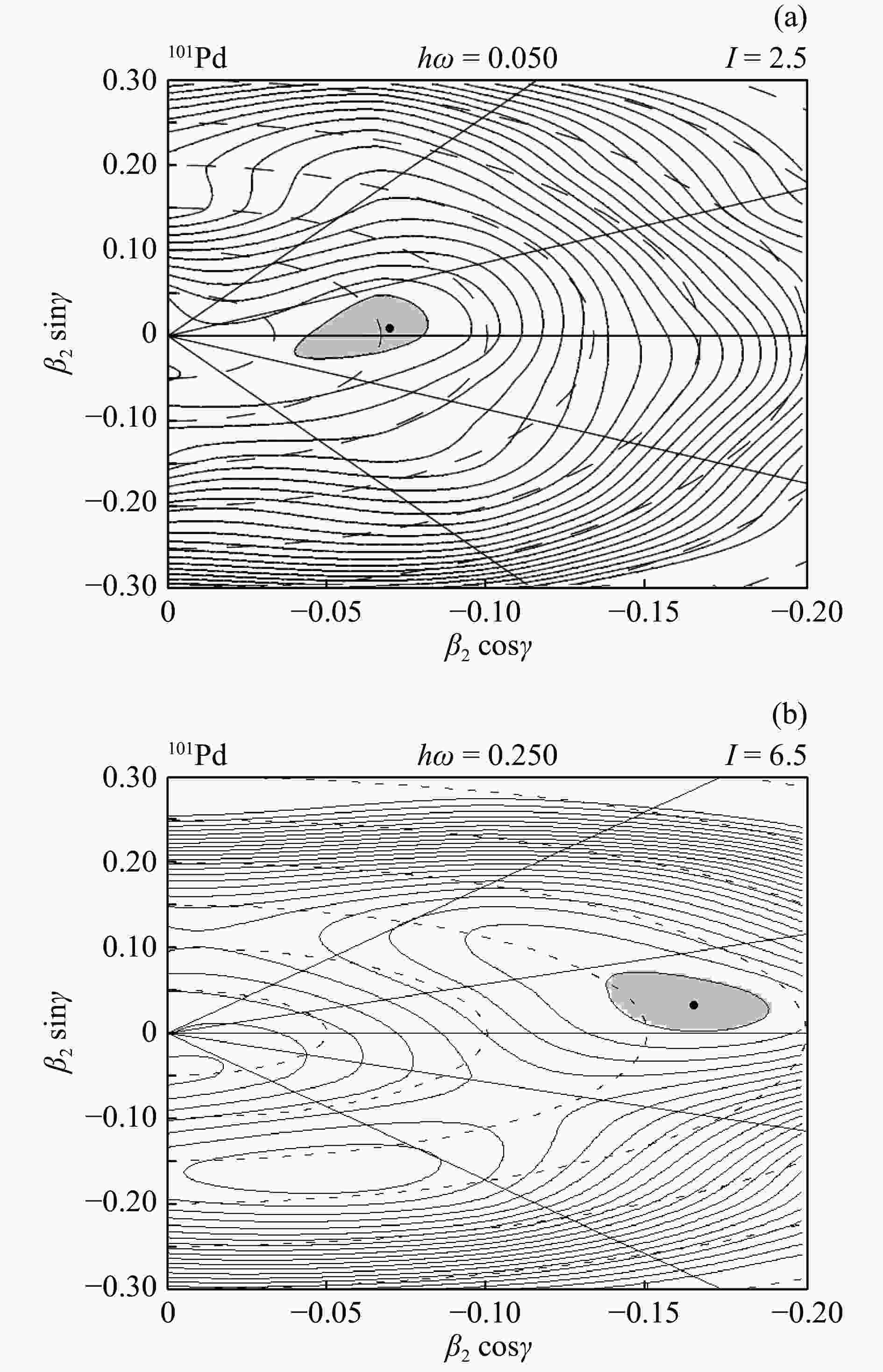



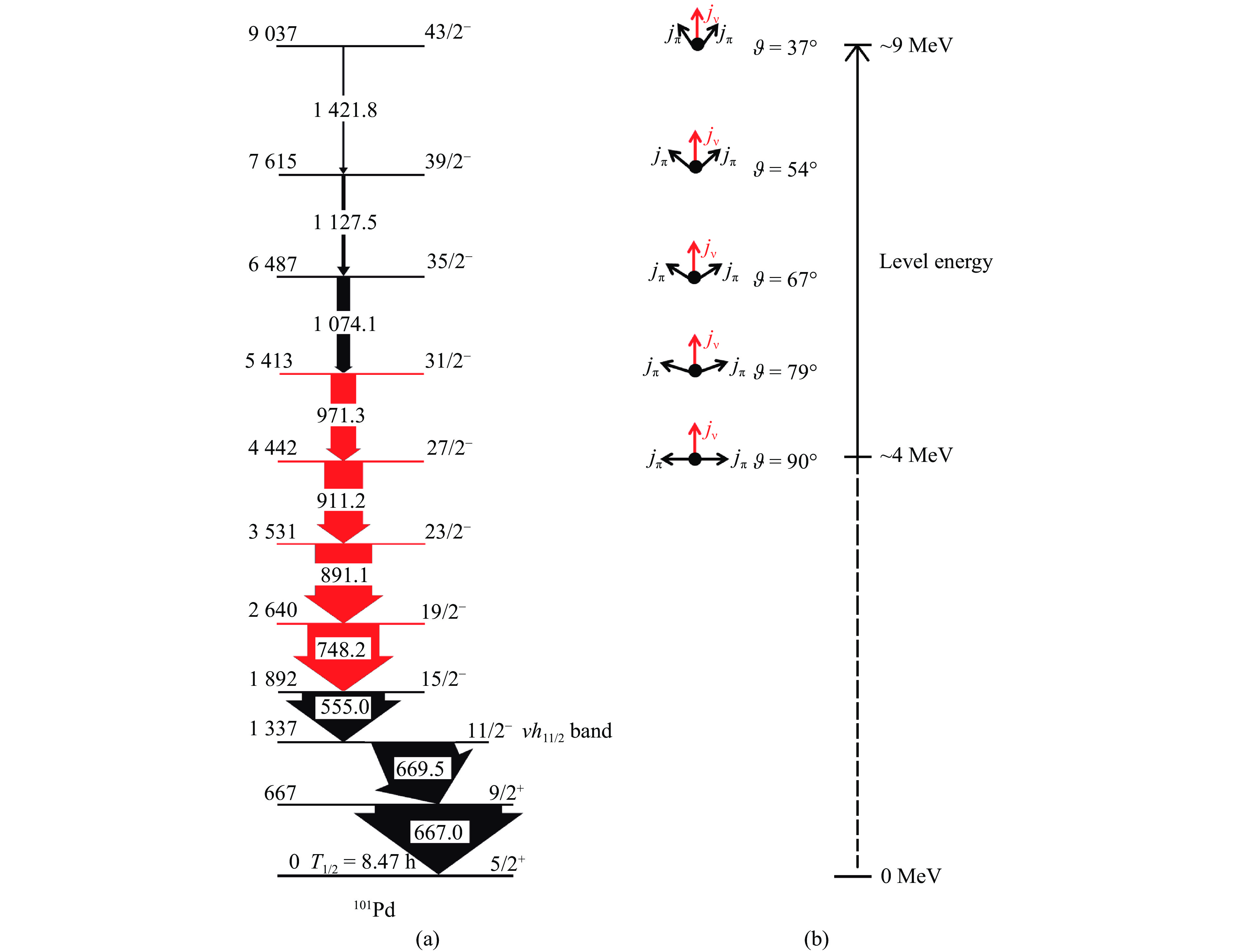
































































 甘公网安备 62010202000723号
甘公网安备 62010202000723号